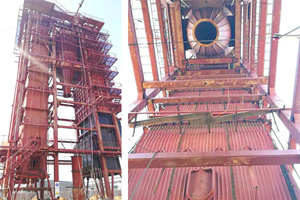(1) Selection principle of refractory materials
Refractory material is the key to determine the service life of the incinerator. The selection principles are as follows:
- Good wear resistance to resist the wear of solid materials and the erosion of hot air;
- Good chemical stability to resist the corrosion of chemical substances in the furnace;
- Good thermal stability to resist the damage to materials caused by changes in furnace temperature;
- High density, low porosity, reduce the probability of acid gas intrusion into the steel shell to cause acid corrosion;
- Suitable refractory selection, economical and durable.
(2) Design of refractory materials
At present, in domestic and foreign hazardous waste incineration projects, the refractory bricks used in rotary kilns mainly include chrome corundum bricks, silicon carbide bricks, mullite corundum bricks, high alumina bricks, etc., which can be selected according to the composition of hazardous waste.
In engineering design, the rotary kiln is often lined with 300mm high-temperature, corrosion-resistant and wear-resistant composite bricks. Inlaid with ceramic fiberboard, the two materials are integrated.
4) Monitoring design of incineration system
The normal operation of the hazardous waste incineration system using rotary kiln is inseparable from safety monitoring. Usually, the parameters that need to be monitored in the rotary kiln incineration system mainly include: the incineration temperature of the rotary kiln, the pressure in the rotary kiln, the temperature of the outer surface of the rotary kiln and the oxygen content in the incineration flue gas. In addition, observation holes and high-temperature camera devices should be installed to observe and monitor the incineration of waste in the kiln.
(1) Rotary kiln incineration temperature monitoring
Temperature monitoring is usually realized by thermocouple thermometer measurement. The specific method is to set up multiple thermocouple monitoring points at the end of the rotary kiln where the flue gas temperature is relatively stable, and use the average temperature of each thermometer to reflect the incineration temperature of the rotary kiln. If the temperature is too low, increase the supply of auxiliary fuel or appropriately reduce the amount of feed; otherwise, reduce or suspend the supply of auxiliary fuel, or increase the amount of feed.
(2) Monitoring of pressure in rotary kiln
The pressure in the rotary kiln is an important parameter for the normal operation of the incineration system. The incineration system requires negative pressure operation. The negative pressure is formed by the suction force of the induced draft fan in the flue gas treatment part to maintain the pressure in the rotary kiln at about -100Pa. If the negative pressure is too large, the air leakage of the system will increase, and the power consumption of the induced draft fan will be high; if the negative pressure is too small, when the combustion conditions fluctuate, the gas in the kiln may overflow outside the kiln. To this end, a differential pressure transmitter is installed on the end plate at the end of the rotary kiln, which transmits the pressure in the rotary kiln to the central control room monitoring system in real time, and participates in incineration control and alarm.
When the pressure of the rotary kiln is too high, the control system will issue an alarm; when it is higher than the high limit set value, the control system will automatically stop feeding, and the incineration system will enter the “waiting” state.
(3) Monitoring of external surface temperature of rotary kiln
The design value of the outer surface temperature of the rotary kiln is generally 180℃, and the fluctuation range is 150℃~360℃. If the temperature is too high or too low, it will increase the corrosion of the outer steel plate of the rotary kiln and reduce its service life. In addition, the temperature of the outer surface of the rotary kiln can also reflect the combustion condition inside the rotary kiln. Therefore, it is necessary to monitor the external surface temperature of the rotary kiln during the operation, and the monitoring is generally carried out by an infrared monitor.
(4) Monitoring of flue gas oxygen content
According to the national hazardous waste control standard, the oxygen concentration in the flue gas should be 6-10%, which is equivalent to the air excess coefficient of 40-91%. The outlet flue of the secondary combustion chamber is equipped with an oxygen content detector to monitor the oxygen concentration in the flue gas, and control the oxygen content of the flue gas at the outlet of the secondary combustion chamber to 6-10%.
The oxygen content and temperature of the flue gas at the exit of the secondary combustion chamber are involved in the interlocking control of the feed. Feeding is only allowed when the temperature and oxygen content are higher than the set minimum limit, which can ensure sufficient combustion of hazardous waste, reduce the amount of particulate matter carried out and prolong the service life of refractory materials.

